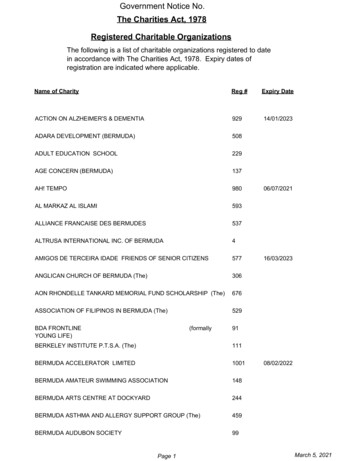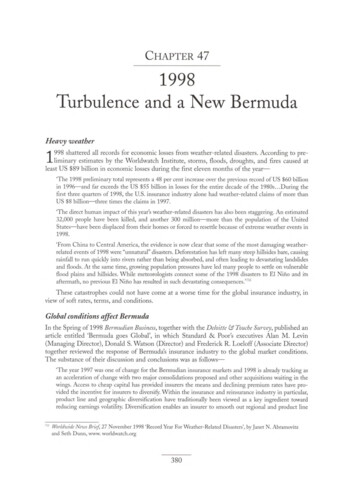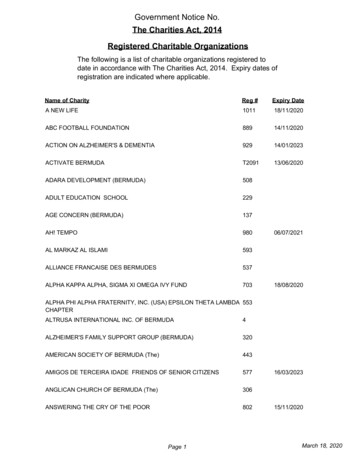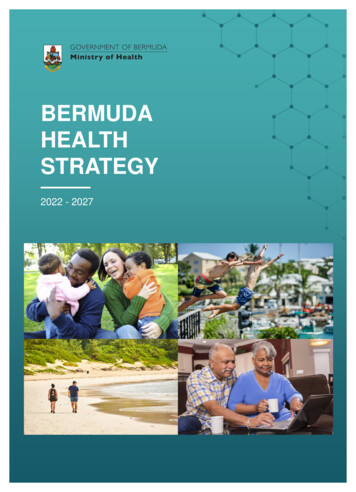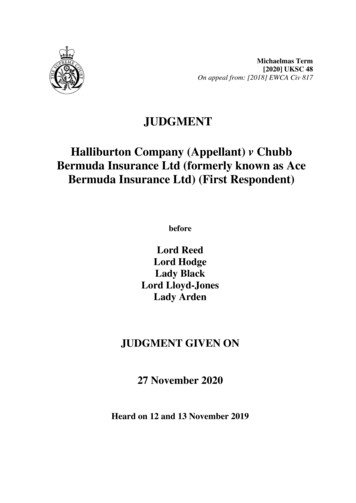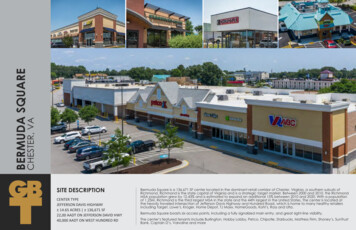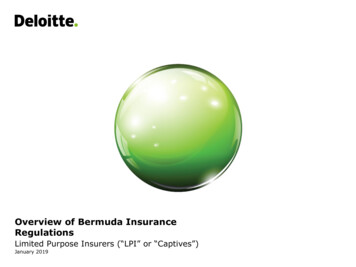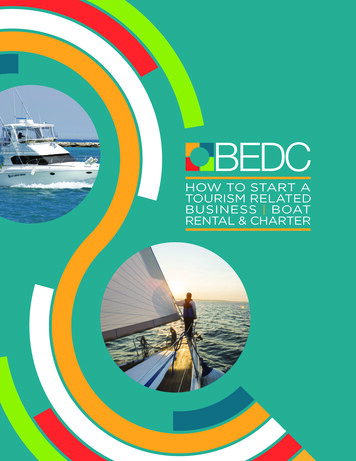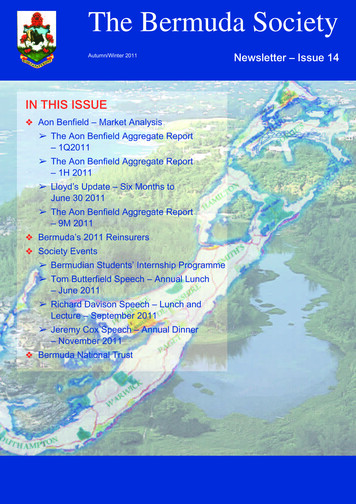
Transcription
The Bermuda SocietyAutumn/Winter 2011IN THIS ISSUEO Aon Benfield – Market Analysis The Aon Benfield Aggregate Report– 1Q2011 The Aon Benfield Aggregate Report– 1H 2011 Lloyd’s Update – Six Months toJune 30 2011 The Aon Benfield Aggregate Report– 9M 2011O Bermuda’s 2011 ReinsurersO Society Events Bermudian Students’ Internship Programme Tom Butterfield Speech – Annual Lunch– June 2011 Richard Davison Speech – Lunch andLecture – September 2011 Jeremy Cox Speech – Annual Dinner– November 2011O Bermuda National TrustNewsletter – Issue 14
The Aon Benfield Aggregate (ABA)Report – 1Q 2011The Aon Benfield Aggregate (ABA) report analyses the2011 first quarter financial position of 28 of the world’sleading reinsurers and examines how 2011 catastrophelosses to date have affected their earnings and capitalpositions.Aon Benfield Analytics estimates that total global reinsurercapital declined from USD470 billion at December 31, 2010to USD440 billion at March 31, 2011 – a decline of 6%; theprimary driver being the high level of insured catastrophelosses in the quarter. This calculation is a broad measure ofcapital available for reinsurance and includes both traditionaland non-traditional forms of reinsurance capital.The latest study compiled by the Market Analysis teamfound that the ABA group of 28 leading reinsurers reportedcapital totalling USD238.3 billion at the end of the firstquarter – a decline of 3.4% or USD8.3 billion from the endof 2010. The main contributory factors were USD4.3 billionof net losses, USD2.5 billion of unrealised investmentlosses, USD2.0 billion of dividend payments and USD2.0billion of share buy-backs.The first quarter combined ratio for the ABA reinsurers roseby 38.3 percentage points to 143.7%, with USD15.1 billionof catastrophe losses representing 57.1% of net premiumsearned. This translated into a property and casualtyunderwriting loss of USD11.5 billion. The total investmentreturn reported by the ABA fell by almost a third to USD9.0billion – driven by a much lower level of capital gains.The overall net loss of USD4.3 billion reported by the ABAreinsurers for the first quarter of 2011 represented a negativereturn on average common equity of 1.8%. This followed areturn of 10.4% or USD23.5 billion for the whole of 2010.Source: Aon BenfieldThe Aon Benfield Aggregate (ABA)Report – 1H 2011Aon Benfield Analytics estimates that global reinsurercapital declined 5% from USD470 billion at December 31,2010 to USD445 billion at June 30, 2011 – with growth of1% observed in the second quarter. This calculation is abroad measure of capital available for reinsurance andincludes both traditional and non-traditional forms ofreinsurance capital.The latest study compiled by the Market Analysis teamfound that the 28 ABA companies reported capital totallingUSD242.4 billion at June 30, 2011 – a decline of 1.7% orUSD4.2 billion since the end of 2010. The main contributoryfactors were USD1.2 billion of net income, USD0.8 billionof new capital and USD2.4 billion of foreign exchange gains– offset by USD7.1 billion of dividend payments andUSD2.5 billion of share buybacks. Half of the capital lost inthe first quarter was recovered in the second.The first half combined ratio for the 28 ABA companies roseby 20.9 percentage points to 120.6%, with USD18.2 billionof catastrophe losses representing 34.1% of net premiumsearned. This translated into a property and casualtyunderwriting loss of USD11.0 billion. The total investmentreturn reported by the ABA fell by 12% to USD18.5 billion– driven by a much lower level of capital gains.The Bermuda Society2The overall net income of USD1.2 billion reported by the 28ABA companies for the first half of 2011 represented areturn on average common equity of 0.5%. This followed areturn of USD23.8 billion – or 10.4% – for the whole of2010.Source: Aon BenfieldAon Benfield’s Lloyd’s Update– 1H 2011Lloyd’s reported a pre-tax loss of GBP697 million for thefirst half of 2011 – driven by unprecedented first halfcatastrophe losses and low investment returns.At almost GBP2.8 billion (USD4.5 billion), first-half majorclaims were double the level of the prior year and more thanten times the long-term average.The underwriting loss stood at GBP1.1 billion – equating toa combined ratio of 113.3% – after GBP470 million of prioryear reserve releases.Despite the high level of catastrophe losses, central assets,members’ funds at Lloyd’s and solvency coverage are atrecord levels.Lloyd’s financial strength ratings have been reaffirmed by A.M. Best at ‘A’ (Excellent), Standard & Poor’s at ‘A ’(Strong) and Fitch Ratings at ‘A ’ (Strong).Based on the limited disclosure to date, there is likely to be amodest overall increase in market capacity for 2012, fromthe current GBP23.3 billion.Source: Aon BenfieldThe Aon Benfield Aggregate (ABA)Report – 9M 2011Aon Benfield Analytics estimates that global reinsurerscapital declined 4% from USD470 billion at December 31,2010 to USD450 billion at September 30, 2011 – withgrowth of 1% observed in both the second and third quarters.This calculation is a broad measure of capital available forreinsurance and includes both traditional and non-traditionalforms of reinsurance capital.The latest study compiled by the Market Analysis teamfound that the 28 ABA companies reported capital totallingUSD245.1 billion at September 30, 2011 – a decline of 0.6%or USD1.5 billion since the end of 2010. ABA capital hasthus rebounded to near peak levels since the 3.4% reductionreported in the first quarter. The main contributory factorswere USD7.0 billion of net income, USD1.8 billion of newcapital and USD1.3 billion of unrealised investment gains –offset by USD8.4 billion of dividend payments and USD3.2billion of share buybacks.The nine month combined ratio for the ABA companies roseby 14.3 percentage points to 110.5%, with USD20.7 billionof pre-tax natural catastrophe losses representing 25.0% ofnet premiums earned. This translated into a property andcasualty underwriting loss of USD8.7 billion. The totalinvestment return reported by the ABA fell by 24% toUSD24.4 billion – driven by a swing from realised andunrealised capital gains of USD9.4 billion to losses ofUSD0.4 billion.
Overall, the ABA reported a pre-tax profit of USD8.2 billionfor the first nine months of 2011 – a 64% reduction relativeto the prior year period. Net income stood at USD7.0 billion– representing a return on average common equity of 2.8%(non-annualised). This followed a return of USD23.8 billion– or 10.4% – for the whole of 2010.For most ABA companies, direct holdings of sovereign debtissued by Portugal, Italy, Ireland, Greece and Spain wereimmaterial at September 30, 2011.Despite the elevated level of catastrophe losses over the lasttwo years, ABA financial strength ratings have remainedbroadly unchanged – reflecting continued robust capitalpositions.Source: Aon BenfieldBermuda’s 2011 ReinsurersThe number of new reinsurers setting up in Bermuda hasincreased by 50% over the past year with 13 new companiesincorporating in December alone.The recent upsurge in registrations has affirmed the Island’sstatus as a world-class centre for insurance according to theBermuda Monetary Authority (BMA), while the Associationof Bermuda Insurers and Reinsurers (ABIR) said thenumbers reflect the Bermuda’s strength in attracting newcapital to the market.Among the most notable additions in December were Class4 re/insurers PaC Re Ltd and Third Point ReinsuranceCompany Ltd. Special Purpose Insurers (SPI) UpsilonReinsurance Ltd, Mercury Insurance Company Ltd, AeolusRe J12 SPI Ltd and Triton Re Ltd also joined the growinglist for December, as did Long-Term Class C reinsurer MSFinancial Reinsurance Ltd, Class 2 insurer DCS RiskManagement Ltd, Class 3A reinsurers Star Re Ltd, AwburyInsurance Ltd, Lion Reinsurance Company Ltd andRocksound Insurance Ltd, and Class 3B reinsurer AQR ReLtd, bringing the count to 53 for the year. This compares to36 registrations in 2010.Leila Madeiros, Senior Vice-President, Deputy Director andCorporate Secretary of the Association of Bermuda Insurersand Reinsurers (ABIR), said that the latest incorporationsindicated Bermuda’s continued ability to attract capital in there/insurance market. “Whilst we are not in a position toknow the specific reasons for the high number ofincorporations during December, the large number ofcatastrophe losses incurred in 2011 may be the catalyst forthe surge,” she said. “Of the 105 billion in global cat lossesin 2011, reinsurers are estimated to have picked up 45% ofthat total.”A spokesman for the BMA said: “The Bermuda MonetaryAuthority is very pleased to note a 50% year-on-yearincrease in insurance registrations – from 36 registrations in2010 to 54 registrations in 2011.”“We are also pleased to note that the 13 registrationsreceived in December 2011 spanned across the majority ofclasses in the Bermuda insurance market ranging fromcaptives and Special Purpose Insurers, to insurers in thecommercial market. This data indicates the market’scontinued confidence in Bermuda as a world-class insurancejurisdiction.”In a separate statement released by the Bermuda StockExchange (BSX), the Exchange reported that it hadsurpassed 3 billion in listed catastrophe bonds andinsurance linked securities (ILS) for the first time at the endof 2011 with 25 ILS worth a total of 3.373 billion.The BSX said that it had been working hard to promoteitself as the top destination for ILS and cat bonds whilelegislative changes made by the BMA had made the Island amore attractive domicile for such securities.“We are absolutely delighted with how 2011 has been for theBSX,” said Greg Wojciechowski, President and CEO of theBSX. “We set out in 2010 to firstly raise the profile ofBermuda and the exchange, and secondly to attract more ILSto the Island and to list on the exchange. We feel we haveachieved a great deal in the last two years.”Of the 25 listed ILS on the BSX four were securitisationprograms, 13 were notes issued under these programmes, sixwere tranches of ILS notes issued as stand-alone securitiesand two are specialist exchange trade fund classes.“All of this activity has happened in the space of about twoyears,” said Mr Wojciechowski. “The momentum is drivenlargely by the BMA’s revised regulations, which in late 2009established a new designation for ‘special-purpose insurers’(SPI) as part of its supervisory scheme. This has been a verypositive step for SPI’s setting up in Bermuda wanting toissue ILS such as catastrophe bonds, and we have been ableto offer them the option of listing these ILS on theexchange.”According to the BMA, 23 special-purpose insurers wereformed in Bermuda during 2011, with the majority of theseformations created specifically to issue catastrophe bonds orcreate sidecars. In 2010, 10 were formed during the sameperiod.Mr Wojciechowski continued: “Bermuda is the world’s thirdlargest reinsurance market and is already home to 1,400insurance companies with total assets of 442 billion, and isa natural place for setting up ILS. Many of our reinsurancecompanies have issued cat bonds or set up special purposevehicles such as side cars so we have a historical interest andknowledge. At the Exchange, we are looking to support itfrom a capital markets perspective any way we can.Institutional investors such as pension and endowment fundsare interested particularly in ILS because of the lowcorrelation between ILS and capital markets. ILS are anatural hedge to capital markets, and listing on the exchangegives them that bit more security. In Bermuda, we also havea critical mass of insurers and reinsurers, the infrastructureto deal with them, and the rigorous regulation from theBermuda Monetary Authority and the Bermuda StockExchange.”Source: The Royal GazetteSociety EventsLecture Meetings, Seminars and ReceptionsThe future programme for Lecture Meetings, Seminars andReceptions is currently being arranged – members will beadvised just as soon as firm dates are known.The Bermuda Society3
AGM and Annual Lunch 2012Arrangements are in hand for the Society’s Annual GeneralMeeting for the year 2012 and the Annual Lunch to be heldat Guildhall in the City of London on Thursday, 07 June next– members will be sent full details nearer the time.Annual Dinner for Members and Guests 2012The Society’s 26th Annual Dinner for Members and Guestswill be held in the Livery Hall at The Worshipful Companyof Armourers and Brasiers in the City of London on theevening of Wednesday, 21 November next – members willbe sent full details nearer the time.Bermudian Students – Internship ProgrammeIt is the Society’s intention to draw upon its wide range ofbusiness contacts from within the international businesssector, banking and financial services, insurance andreinsurance, and the law and accounting professions – andoffer a competitively rated, paid internship programme ate/postgraduate degree in the UK.It is envisaged the programme will take place over 5-6weeks in June/July 2012 – this will provide those whoqualify for the programme with invaluable experienceobtained from a high-quality learning environment.Interns will be required to arrange their own accommodationfor the duration of the programmeSuzanne StubbinsSecretaryThe Bermuda SocietySpeech given by Tom Butterfield,Founder and Creative Director,The Masterworks Museum ofBermuda Art at The BermudaSociety’s Annual Lunch 2011 heldat Guildhall in the City of Londonon Tuesday, 14 June 2011.Good Day.Pablo Picasso said, “Art washes away from the soul the dustof everyday life”. Thank you for giving me the opportunityto address The Bermuda Society. It is a great honour to beback at the Guildhall seven years after Masterworks openedthe exhibition “Painters in Paradise”- Albeit I am withoutvisuals this time, so you will have to bear with me, closeyour eyes and imagine.It is a Sunday in January 1988 at 9 p.m. A pre-taped interviewof yours truly is on television, attempting to explain the newlyborn notion of the Masterworks Collection to the Bermudianpublic. The telephone rings “Mr. Butterfield.”At the time, this was the prevailing attitude toward the finearts in Bermuda, and an indicator of the work we had infront of us. Yes, the Archives, the Bermuda National Trust,the Maritime Museum and the Art Centre at Dockyardexisted and their contribution to the national awareness isnoted, but none of them were able to present a record of ourThe Bermuda Society4collective artistic heritage and consciousness. To be kind,our welcome into this climate was less than salubrious andwe were not sure if we had opened an Aladdin’s Cave or aPandora’s Box! Recently, my colleague Elise Outerbridge,came across some correspondence from the esteemed artistand visionary behind the Bermuda National Gallery,Hereward Watlington who wrote to Karl Rodgers in 1965, “Ihave been advised that the Trade Development Board (nowthe Bermuda Tourism Board) is endeavouring to interestpeople in coming to Bermuda during the winter months, andfor those for whom golf holds no charm, it is necessary tofind other interests. A suggestion was made to them that anexhibition of the work of distinguished artists who hadworked in Bermuda was thought to be good. Unfortunately, Idoubt if the careers of many of them have been followed toknow exactly who they were, but there are at least three,your uncle (Ambrose Webster), Charles Hawthorne andWinslow Homer.”The notion of “Cultural Tourism” was incubated, but itwould be another twenty years before we grabbed the balland ran with it. Watlington again alluded to the reason whythis idea was difficult to execute in a letter of February 27,1968, “Recently, whenever exhibitions were mooted,galleries put so many obstacles in the way that they have hadto give up.” So here it is our “Myth of Sisyphus”.Undaunted, we persevered and the idea was realized in 1987when, with the loan of 60,000, we returned twelvepaintings to the Island which gave shape, form andsubstance to Bermuda’s artistic roots and heritage.My mother died a year ago, almost to this very day, and inthat time, many interesting facts and artifacts unknown to ushave surfaced to the delight of the remaining family. Shekept all our letters from school (and, with 5 children, thatwas no mean feat!) – our school reports, newspaperclippings – the whole shebang! So I read the followingreport card from December 1955:“Tom has worked well during the term. His reading hasimproved and is becoming more fluent. His paintings anddrawings are carefully executed but needs to be livelier. Tomenjoys all group activities and is a pleasant and most helpfulmember of the group.”Mary BeattieForm MistressThe Headmistress writes:“Tom is a promising scholar”.A promising scholar! Scholarship eluded me completely;“scholarship” went to my older brother in the form ofRhodes. The 60’s were to hit me pretty hard – change,demonstration, anti-establishment, counter-culture – the lot.By the time the haze and fog of that period had burnt off, Ihad graduated with distinction and on to a more constructiveand contributing life. However, the seeds for the “ArtGuerillas” had been sown.Returning to Bermuda in 1980, my wish was to continue afree-lance career in art, printmaking and photography. Thiswas not to be. I realized in my first month back on the Islandmy electricity bill was higher than my combined mortgage,utility and food bills had been in Toronto, so I went into thewine business. By 1984, there was a small shift inBermuda’s cultural awareness which was apparent when Istarted volunteering for the Heritage Advisory Committee. Itwas soon clear that the absence of Bermudian selfknowledge and confidence (including that of my own) was
due in large part to the lack of access and assemblage.Although institutions existed to serve the academic orscholar – call it what you want – nothing was available forboth locals and visitors to reference something of theIsland’s history and culture – not even a mere glimpse. Soafter the successful run of the exhibition during Heritagemonth in 1985, the next year we endeavoured to go up anotch and bring back to the Island a treasure of real note. Wescored a triumph with nothing less than the American artistAndrew Wyeth’s watercolour, “Royal Palms” painted in1952 – one of only three of his Bermuda works in existence.As we were keen to focus on the very narrow parameters of“Inspired by Bermuda”, a private individual had loaned us aglorious Ogden Pleissner watercolour of St. Georges and apainting by Renoir. The Renoir never saw daylight. It stayedin the closet. The show had a two-week run and attractedthousands, which confirmed to us that the formula workedand begged the question, “If Winslow Homer, GeorgiaO’Keeffe and Andrew Wyeth were inspired by the beauty ofBermuda, who else?” It was apparent that the interest in ourculture now stretched beyond “Heritage Month” and ourcompass had been set – although the waters were obviouslyuncharted. We followed Bermuda’s motto “Quo Fata Ferunt”translated- “Where the fates carry us”.For decades, Bermuda’s traditions, history, folklore or culturelay in the empirical evidence of the things that they could see,whether it was in the form of a gombey, a fitted dinghy or ourunique architecture. The National Trust, The MaritimeMuseum and the Bermuda Historical Society as well as ourbeaches, golf courses and even rum added to our vast pride.So whether it was a cross or an astrolobe from the ocean flooror silver and cedar made by local artisans and craftsmen – atthe time they were thought of as our greatest treasures andcultural assets. All that would begin to change commencing inthe summer of 1987, a journey whose story is still evolvingtoday. Bermuda, an environment of business and banking, wastherefore not so willing to support an idea based on emotion,passion and “what ifs”. With accountants, analysts, andactuaries outnumbering artists, there was no room foruncertainty. Predicting any outcomes of our activities andenergies was impossible. It was all vision, obscured by theunknown. Our notion was the antithesis of the climate. Itwould be almost impossible to imagine twenty five years agothat the Masterworks Museum would be honoured as “BestActivity and Attraction” for visitors as it was recently – notdiving schools, golf courses, tennis courts or catamarans withCalypso music – a MUSEUM gets best activity! Perhaps it isbecause – as one supporter so keenly observed – “The(Masterworks) Collection represents a repository lookingforward, not backward.” By the very nature of its makeup, theCollection is unique and wholly representative of ourtraditions and environment. Today, Bermudians and visitorsare safe in the knowledge that we no longer just write aboutthe visits of great artists, but continue to add to the culturalwealth of the future through acquisitions of excellence,including a series of charcoal drawings of Bermuda shells byHenry Moore which the Henry Moore Foundation have put onpermanent loan to the Museum. We were becoming part of theart world and we did not want to offend the “powers that be”(which we did) as we wanted to stay at the party. From time totime, we did think of ourselves as “Art Guerillas” and rufflethe feathers of the establishment now and then, but our intentwas to open up new possibilities for all.Ross Sterling Turner’s watercolour, “Fairylands”, one of thefirst twelve works in the collection, dating from 1885. Thiswas the year the “S.S. Trinidad” first brought visitors to theIsland and the doors to tourism officially opened. Many inthe academic and commercial circles had long known of thevisits of Winslow Homer and Georgia O’Keeffe to Bermuda.The fact that O’Keeffe was married to Alfred Steiglitz, thegreat American photographer and mentor to AmericanModernism, made us ‘Trip the Light Fandango’ when werealized through his Gallery 291, he had encouraged thelikes of Marsden Hartley, Charles Demuth, Karl Struss,cubist Albert Gleizes and Carl Sprinchorn to find inspirationon the island, and as a result, some great additions to theCollection. Other prominent literary visitors, such as EugeneO’Neill, Charlie Chaplin, Mark Twain and Rudyard Kipling,added to overall cultural aura of Bermuda. Despite a woefullack of funds and a sense from some sectors of thecommunity to do something more permanent wasunthinkable, stubborn determination drove us to continue to“connect the dots” and push the rock up hill. A fascinatingpicture was emerging.THE MASTERWORKS MISSION STATEMENT:THROUGH THE MEDIUM OF VISUAL ARTS TO AWAKENAND NURTURE A SENSE OF THE UNIQUE CHARACTEROF BERMUDA, ITS HISTORY AND ITS CULTURETHROUGH DISPLAYING THE MASTERWORKS COLLECTIONAND THROUGH OFFERING EDUCATIONAL PROGRAMMESTO THE COMMUNITY AT LARGE, TO ATTRACT ANDINSPIRE ARTISTS FROM ABROAD AND, AT THE SAME TIME,TO ENCOURAGE BERMUDIANS OF ALL AGES, AMATEURAND PROFESSIONAL, TO DEVELOP THEIR CREATIVEAND ARTISTIC TALENT IN ORDER THAT THEY MAYCONTRIBUTE TO THE GENERAL BENEFIT OF BERMUDA.Armed with the Mission Statement, there was no avenue wewould not pursue if we felt the end result would enhanceMasterworks and the ever-growing menu of activities thatwere developing in conjunction with the collection. Onenight that really saved our sense and sensibility wasproducing a Telethon to repatriate three portraits of workingclass Bermudians by Ambrose Webster. The evening was aresounding success – in two hours we had raised 50,000from a population numbering just about the same and wewere then a mere seven years old. Three years ago, wefinally realised our dream and opened a “state of the art”museum, which has seen tens of thousands enter through itsdoors. Add to that, in the course of a year, we welcomethousands of students who participate in summer classes,half term breaks, Christmas and Easter breaks, “Arts for All“ and “Super Saturday”. The Museum is now a viable entityon the cultural landscape. We have made every effort tomake both the Museum and its collection available,approachable and accessible. We have long held the viewthat we are in the Education, Entertainment and Hospitalitybusiness- without any apology. As Marshall McCluhan said,“Anyone who tries to make a distinction between educationand entertainment does not know the first thing about either.”It’s a “hands on” approach – there are limits to beingprecious and we hope never to be accused of that! Weencourage parents, children and visitors to make theMuseum home and we hope to fortify the idea that thetreasures and Museum belong to all. To be realistic, these aredifficult times and the irony is not lost that the arts usuallyget the first cut when the economy flounders. Perhaps it isthe easiest, as the din of protest coming from the museumThe Bermuda Society5
world seems to be the quietest. In our 24-year history, thefinancial help from the Government has barely registered onthe Richter scale, although we are eternally grateful for the“gift” at a Peppercorn Rent ( 1.00 per year) of theunbelievably beautiful piece of land in the middle of theBotanical Gardens. This was a most generous gift. We havehad some help from Tourism with the traveling exhibitionand recently have partnered with them to attract visitors intothe Museum through open house activities.The words “serendipity” and “collecting” have a certainsynergy – but add to that a lot of passion and total optimismand you get the final product. The story of how theMasterworks Collection was assembled was certainly that!The wise advise of my aforementioned mother in regard toour first acquisitions (A.K.A. the “Twelve Apostles”) was acase in point. We had the choice of using our newlyborrowed funds to buy one pencil drawing by GeorgiaO’Keeffe called “The Banyan Tree” or twelve works bylesser known – but equally compelling – artists. Mum said,“Go with the group – it will give you more to hang your haton. and you will probably get the other one anyway.” Andyou know what? She was right, because in 1992 I ran mythird London Marathon to raise the funds for the O’Keeffe(along with a legacy gift left in memory of a dear friend,Wendy Wilkinson, who died at an untimely young age) andwe now had a work by one of the artistic icons of thetwentieth century as well. But it was later that year that wereally became a force to be reckoned with. A local familytrust purchased one of the most outstanding Bermudawatercolours by Winslow Homer “Inland Water” and it wasgiven to Masterworks on long-term loan. Now we were inthe big league, and people sat up and paid attention to thelittle upstart, Masterworks.It seemed as if each day, each month, brought an excitingchallenge – we never knew when a wonderful work of artwould turn up and then how we would manage to pay for it –we have no endowment fund and banks don’t give lines ofcredit for art work! In the middle of the Capital Campaign tobuild the Museum, yet another Winslow Homer watercolourshowed up for sale called “Opposite Ireland Island”. I hadVOWED that I would not even entertain the notion of tryingto buy ANY art until after the building was completed, butthis was just too tempting to resist. Being blessed with asmall group of patrons who support the purchase of artwork(don’t ask them for money for “bricks and mortar”!) wewere able to make this important addition. Anothercollecting highlight was in 2006, when a work by MarsdenHartley, the quirky genius of American Modernism, caughtour eye. We already had one work by Hartley, “SunkenTreasure” from a later period. This particular work,“Movement Bermuda, 1917” was done when he came toBermuda with fellow artist Charles Demuth and was thenjoined by Albert Gleizes; their work in Bermuda literallychanged the course of American painting. “Movement” wasnoted by a curator at the Smithsonian Institute at the time ofthe auction as “one of the most important Americanpaintings ever done.” If you have ever participated in theauction process at either Christies or Sotheby’s, you knowwhat a hair-raising experience it can be. You can bet ourlittle hearts were racing as we listened over the phone whileour more intrepid colleagues proceeded with the bidding andwhen the hammer went down, it was ours. for 900,000 –again a huge thanks to some truly generous donors whoknew how important this painting would be to the collection.In conclusion, on the eve of our 25th birthday next year, IThe Bermuda Society6would like to highlight 25 important milestones from thepast quarter century:1987 – The purchase of the first 12 paintings;1988 – Establishing a Board of Trustees and being given ourfirst home at 47 Front Street;1992 – Return of Homer’s watercolour “Inland Water”;1993 – Start of our 1st educational initiative-“ArtistsEncounters”;1994 – The Georgia O’Keeffe exhibition;1994 – The first Masterworks “coffee table” book;1995 – First Edinburgh to London Charity bike ride;1995 – ZBM telethon to raise 50,000 for Webster portraits;1997 – First Artist-in-Residence at Dockyard;2000 – Purchase of “Crusade” by Malcolm Morley (winnerof the 1st Turner Prize);2000 – “A twofer” – the return of Gleizes “Juliette” andHartley’s “Sunken Treasure” in one go;2000 – 2008 – Travelling the collection to Toronto, NewYork, Boston. London and Philadelphia;2001 – Being given a 42 year lease by Government;2003 – Receiving the patronage of H.R.H. Prince Charles;2004 – Returning Homer’s “Opposite Ireland Island”;2004 – Commencement of building the museum;2007 – Roof wetting ceremony with Michael Douglas;2008 – March – The Masterworks Museum of Bermuda Artofficially opens in the Botanical gardens;2008 – The first Charman prize;2009 – Being part of the 400th anniversary with Jamestown;Opening of Homer’s Café;The visit of H.R.H the Duchess of Gloucester for theopening of the exhibition “Floral Lane”;2011 – V.I.P. award for best activity and attraction;2011 – Talking to the Bermuda Society today!Being blessed with a dedicated staff.It has been suc
c l ai msw erd oub tv f p y n eni ms h lo g- rav . The underwriting loss stood at GBP1.1 billion - equating to a combined ratio of 113.3% - after GBP470 million of prior year reserve releases. D espi thg lv of c ar ,n m eb r'fu nd atL l oy vc g record levels. L lo yd' s fiac t r eg h v bm A. M. B e ta 'A '(Exc l n), S d r& P o
